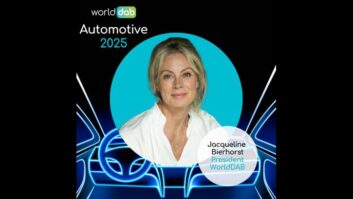The author is project director of RadioDNS. His commentaries appear regularly in Radio World.

Consider two organizations, both well established, commercially successful and global in reach. One makes products that the other distributes to consumers, each equally reliant on the other.
It would be pointless to make a product that couldn’t be distributed to consumers, or to create a distribution network for a product that doesn’t exist. And yet that happens when radio stations create services that car radios can’t use, and car radios implement functionality that radio stations don’t support. It’s a waste of time (and money) that we don’t have a lot of. When auto manufacturers work with companies like Spotify or Sirius XM, they get a clear brief, consistently implemented.
[Read: SurferNetwork Partners With RadioDNS]
Part of the challenge is the diversity and scale of the radio industry. Radio isn’t one single organization, but a myriad of different owners, brands, products and technical capabilities. On the relatively egalitarian radio dial, a huge media organization with big production budgets can be side-by-side with a small community broadcaster that works hard to stay on-air. Both have a presence that needs to be available to consumers. When you’re an automotive manufacturer, you can hear from a cacophony of radio stations, and working out if they’re all asking for the same things but in different ways is impossibly time-consuming.
The radio industry is getting better at focusing its requirements and communicating them clearly, and the automotive industry is getting better at realizing that communication with broadcasters avoids costly misunderstandings. Organizations like the NAB, WorldDAB and RadioDNS create opportunities for both sides to talk through the detail of how to implement the best possible radio experience in the car.
WorldDAB and RadioDNS jointly organize Automotive Workshops three times a year, specifically to address things that aren’t working as well as could be expected. These roundtable meetings discuss a mixture of current implementation issues, and identify gaps in functionality that could be easily closed. This focus on here, now and addressable problems is very different from the longer term horizon of groups like the WorldDAB Technical Committee or the RadioDNS Technical Group.
At the latest workshop, held in February 2021, we discussed current issues where we can see that the alignment between broadcasters and manufacturers isn’t right, and is causing problems.

On the subject of providing real-time metadata, we looked at the big divergence between the relatively widespread support in cars for DL+ (and RT+), which allows specific identification of artist, title and other key pieces of metadata, and the fairly poor support of it by broadcasters. It was an opportunity for auto manufacturers to show how that function is displayed to drivers and why they value it, which was new information for many broadcasters. It’s a function that’s implemented and broadcasters haven’t been utilizing because they didn’t understand why they should.
We also discussed driver distraction, which is influencing so many decisions in the automotive industry about what drivers can see and can do. We talked about how broadcasters could reduce the risks of creating distractions by considering issues such as the repetition speed of text information and tailoring visual content to consider design elements like text size, text density, colors and brightness, particularly the potential for distracting glare from bright images during night time. It’s an effective way for manufacturers to educate broadcasters on how to create content and support functionality that manufacturers want and can include in vehicles.

RadioDNS and WorldDAB run a help desk facility for broadcasters and manufacturers, recognizing that often the problem with solving a problem is getting hold of the right person. By acting as an information exchange, they can route problems to the people who can solve them, and look out for trends and issues that should be addressed by the whole community.
At the workshop RadioDNS and WorldDAB also announced they will be carrying out an extensive and detailed survey of manufacturers’ and broadcasters’ capabilities, to identify and close as many implementation gaps as possible. The first results will be presented to the next workshop, and comprehensive results available later in the year. It’s an opportunity to create a step change in the experience of radio in cars on the road today for the least effort on behalf of both broadcasters and manufacturers.
The automotive workshops are unique in structure, encouraging interaction and discussion about implementation and problem solving. With over 70 people attending the last workshop, they’re also very well attended with people with knowledge and ability.
The next WorldDAB and RadioDNS Automotive Workshop will be on June 8. Information about registration will be made available close to the time, on both the WorldDAB and RadioDNS websites.







